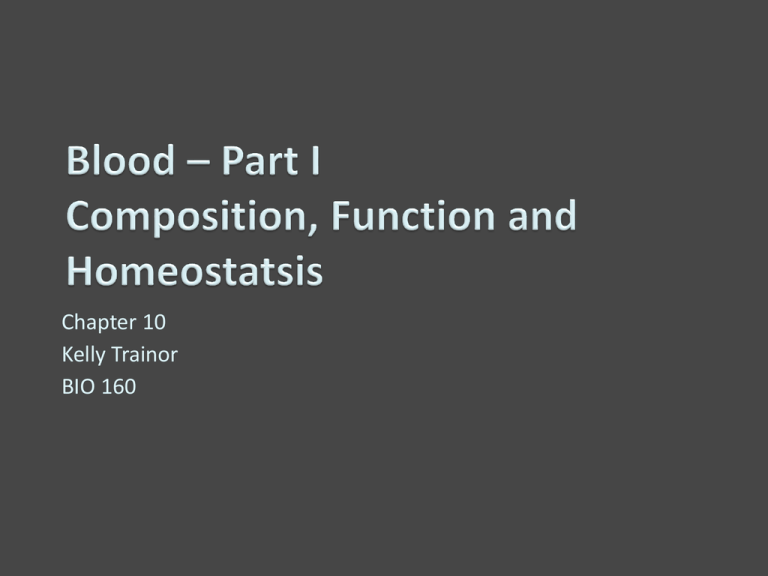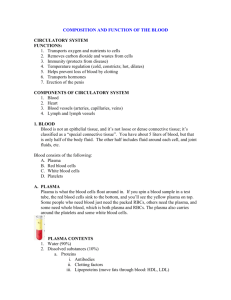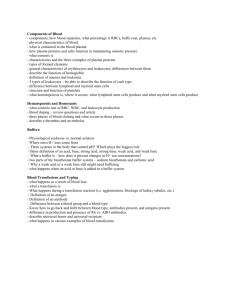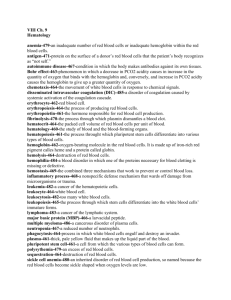Blood F10
advertisement

Chapter 10 Kelly Trainor BIO 160 Describe the composition and volume of whole blood Describe the composition of plasma and discuss its importance List the cell types making up the formed elements and describe the major functions of each type Describe the blood clotting process The only fluid tissue in the human body Classified as a connective tissue Components of blood ◦ Living cells Formed elements ◦ Non-living matrix Plasma If blood is centrifuged ◦ Erythrocytes sink to the bottom (45% of blood, a percentage known as the hematocrit) ◦ Buffy coat contains leukocytes and platelets (less than 1% of blood) Buffy coat is a thin, whitish layer between the erythrocytes and plasma ◦ Plasma rises to the top (55% of blood) Color range ◦ Oxygen-rich blood is scarlet red ◦ Oxygen-poor blood is dull red pH must remain between 7.35–7.45 Blood temperature is slightly higher than body temperature at 100.4°F In a healthy man, blood volume is about 5–6 liters or about 6 quarts Blood makes up 8% of body weight Composed of approximately 90% water Includes many dissolved substances ◦ Nutrients ◦ Salts (electrolytes) ◦ Respiratory gases ◦ Hormones ◦ Plasma proteins ◦ Waste products Plasma proteins ◦ Most abundant solutes in plasma ◦ Most plasma proteins are made by liver ◦ Various plasma proteins include Albumin—regulates osmotic pressure Clotting proteins—help to stem blood loss when a blood vessel is injured Antibodies—help protect the body from pathogens Acidosis ◦ Blood becomes too acidic Alkalosis ◦ Blood becomes too basic In each scenario, the respiratory system and kidneys help restore blood pH to normal Erythrocytes ◦ Red blood cells (RBCs) Leukocytes ◦ White blood cells (WBCs) Platelets Cell fragments Hemocytoblast stem cells Lymphoid stem cells Myeloid stem cells Secondary stem cells Erythrocytes Platelets Lymphocytes Basophils Eosinophils Monocytes Neutrophils Erythrocytes (red blood cells or RBCs) ◦ Main function is to carry oxygen ◦ Anatomy of circulating erythrocytes Biconcave disks Essentially bags of hemoglobin Anucleate (no nucleus) Contain very few organelles ◦ 5 million RBCs per cubic millimeter of blood Hemoglobin ◦ Iron-containing protein ◦ Binds strongly, but reversibly, to oxygen ◦ Each hemoglobin molecule has four oxygen binding sites ◦ Each erythrocyte has 250 million hemoglobin molecules ◦ Normal blood contains 12–18 g of hemoglobin per 100 mL blood Homeostatic imbalance of RBCs ◦ Anemia is a decrease in the oxygen-carrying ability of the blood ◦ Sickle cell anemia (SCA) results from abnormally shaped hemoglobin ◦ Polycythemia is an excessive or abnormal increase in the number of erythrocytes Leukocytes (white blood cells or WBCs) ◦ Crucial in the body’s defense against disease ◦ These are complete cells, with a nucleus and organelles ◦ Able to move into and out of blood vessels (diapedesis) ◦ Can move by ameboid motion ◦ Can respond to chemicals released by damaged tissues ◦ 4,000 to 11,000 WBC per cubic millimeter of blood List of the WBCs from most to least abundant ◦ Neutrophils Hemocytoblast ◦ Lymphocytes stem cells ◦ Monocytes Lymphoid Myeloid stem cells stem cells ◦ Eosinophils Secondary stem cells ◦ Basophils Easy way to remember this list ◦ Never ◦ Let ◦ Monkeys ◦ Eat ◦ Bananas Erythrocytes Platelets Lymphocytes Basophils Eosinophils Monocytes Neutrophils Blood cell formation Occurs in red bone marrow All blood cells are derived from a common stem cell (hemocytoblast) Hemocytoblast differentiation ◦ Lymphoid stem cell produces lymphocytes ◦ Myeloid stem cell produces all other formed elements Hemocytoblast stem cells Lymphoid stem cells Myeloid stem cells Secondary stem cells Erythrocytes Platelets Lymphocytes Basophils Eosinophils Monocytes Neutrophils Unable to divide, grow, or synthesize proteins Wear out in 100 to 120 days When worn out, RBCs are eliminated by phagocytes in the spleen or liver Lost cells are replaced by division of hemocytoblasts in the red bone marrow Stoppage of bleeding resulting from a break in a blood vessel Hemostasis involves three phases ◦ Vascular spasms ◦ Platelet plug formation ◦ Coagulation (blood clotting) Thrombus ◦ A clot in an unbroken blood vessel ◦ Can be deadly in areas like the heart Embolus ◦ A thrombus that breaks away and floats freely in the bloodstream ◦ Can later clog vessels in critical areas such as the brain Thrombocytopenia ◦ Platelet deficiency ◦ Even normal movements can cause bleeding from small blood vessels that require platelets for clotting Hemophilia ◦ Hereditary bleeding disorder ◦ Normal clotting factors are missing Chapter 10 Kelly Trainor BIO 160 Describe the ABO and Rh blood groups Explain the basis for a transfusion reaction Large losses of blood have serious consequences ◦ Loss of 15–30% causes weakness ◦ Loss of over 30% causes shock, which can be fatal Transfusions are the only way to replace blood quickly Transfused blood must be of the same blood group Blood contains genetically determined proteins Based on the presence or absence of two antigens ◦ Type A ◦ Type B The lack of these antigens is called type O The presence of both antigens A and B is called type AB The presence of antigen A is called type A The presence of antigen B is called type B The lack of both antigens A and B is called type O Antigens (a substance the body recognizes as foreign) may be attacked by the immune system Antibodies are the “recognizers” Blood is “typed” by using antibodies that will cause blood with certain proteins to clump (agglutination) There are over 30 common red blood cell antigens The most vigorous transfusion reactions are caused by ABO and Rh blood group antigens Blood type AB can receive A, B, AB, and O blood ◦ Universal recipient Blood type B can receive B and O blood Blood type A can receive A and O blood Blood type O can receive O blood ◦ Universal donor Named because of the presence or absence of one of eight Rh antigens (agglutinogen D) that was originally defined in Rhesus monkeys Most Americans are Rh+ (Rh positive) Problems can occur in mixing Rh+ blood into a body with Rh– (Rh negative) blood Danger occurs only when the mother is Rh– and the father is Rh+, and the child inherits the Rh+ factor Mother can receive a shot of anti-Rh+ antibodies to prevent a buildup of Rh+ antibodies The mismatch of an Rh– mother carrying an Rh+ baby can cause problems for the unborn child ◦ The first pregnancy usually proceeds without problems ◦ The immune system is sensitized after the first pregnancy ◦ In a second pregnancy, the mother’s immune system produces antibodies to attack the Rh+ blood (hemolytic disease of the newborn) Blood samples are mixed with antiA and anti-B serum Coagulation or no coagulation leads to determining blood type Typing for ABO and Rh factors is done in the same manner Cross matching—testing for agglutination of donor RBCs by the recipient’s serum, and vice versa Sites of blood cell formation ◦ The fetal liver and spleen are early sites of blood cell formation ◦ Bone marrow takes over hematopoiesis by the seventh month Fetal hemoglobin differs from hemoglobin produced after birth Physiologic jaundice results in infants in which the liver cannot rid the body of hemoglobin breakdown products fast enough






